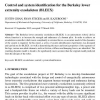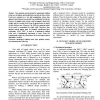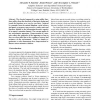473 search results - page 19 / 95 » From experiment design to closed-loop control |
AR
2006
13 years 8 months ago
2006
The Berkeley lower extremity exoskeleton (BLEEX) is an autonomous robotic device whose function is to increase the strength and endurance of a human pilot. In order to achieve an e...
CHI
2007
ACM
14 years 8 months ago
2007
ACM
Traditionally, software engineering processes are based on a formalist model that emphasizes strict documentation, procedural and validation standards. Although this is a poor fit...
ICRA
2006
IEEE
14 years 2 months ago
2006
IEEE
- Time optimal control method for quadruped walking robots are developed and installed into a practical robot system. Each leg is modeled as a two link manipulator whose time optim...
BMCBI
2007
13 years 8 months ago
2007
Background: Chromatin immunoprecipitation on tiling arrays (ChIP-chip) has been widely used to investigate the DNA binding sites for a variety of proteins on a genome-wide scale. ...
CEC
2005
IEEE
14 years 1 months ago
2005
IEEE
Abstract- The classical approach to using utility functions suffers from the drawback of having to design and tweak the functions on a case by case basis. Inspired by examples from...




